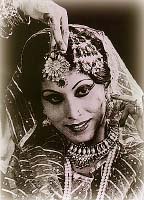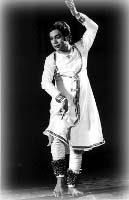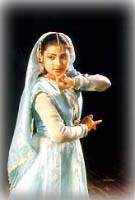Kathak
 Kathak is one of the major classical dance forms of northern India. The word kathak means "to tell a story". It is derived from the dance dramas of ancient India. When the patronage shifted from the temples to the royal court, there was a change in the overall emphasis.
Kathak is one of the major classical dance forms of northern India. The word kathak means "to tell a story". It is derived from the dance dramas of ancient India. When the patronage shifted from the temples to the royal court, there was a change in the overall emphasis.
| History & Origin |
The Kathak originated in the State of Uttar Pradesh and Prajasthan. It was originally performed by communities of people called Kathakaras or story teller. Kathak is also known as Braj Raas.
This dance form traces its origins to the the nomadic bards of ancient northern India, known as Kathaks, or story tellers. These bards, performing in village squares and temple courtyards, mostly specialized in recounting mythological and moral tales from the scriptures, and embellished their recitals with hand gestures and facial expressions.
It was quintessential theatre, using instrumental and vocal music along with stylized gestures, to enliven the stories. With the advent of Mughal culture, Kathak became a sophisticated chamber art. Patronized by art loving rulers, the practitioners of Kathak worked at refining its dramatic and rhythmic aspects, delighting elite audiences with their mastery over rhythm and the stylized mime.
 There are three main gharana, or schools of kathak. These schools are named according to the geographical area in which they developed. These are the Jaipur, Lucknow, and the Benares gharanas. Each has a slight difference in interpretation and repertoire.
There are three main gharana, or schools of kathak. These schools are named according to the geographical area in which they developed. These are the Jaipur, Lucknow, and the Benares gharanas. Each has a slight difference in interpretation and repertoire.
| Performance & Features |
The dance usually commence after invocation (Ganesha Vandana) to Lord Ganesha.The dance contains the following comments: Thata, the opening sequence, Amad which corresponds to the Alarippu in Bharata Natyam, Paran which is considered the piece de resistance of the dance and finally the Tarana which correspond to the Thilland of Bharata Natyam.
A notable feature of Kathak is the intricate footwork and the highlight of the dance is the Tahai, a spinning movement in one spot at great speed.Both men and women perform this dance. Music composition is based on lyrics such as Thumri, Dadra, Ghazal and Kavitas.
 The technique of Kathak today is characterized by fast rhythmic footwork set to complex time cycles. The footwork is matched by the accompanying percussion instruments such as tabla and pakhawaj, and the dancer and percussionists often indulge in a virtuoso display of rhythmic wizardry. The dance movements include numerous pirouettes executed at lightning speed and ending in statuesque poses. The interpretative portion, based on tales of Radha and Krishna and other mythological lore, contains subtle gestures and facial expressions.
The technique of Kathak today is characterized by fast rhythmic footwork set to complex time cycles. The footwork is matched by the accompanying percussion instruments such as tabla and pakhawaj, and the dancer and percussionists often indulge in a virtuoso display of rhythmic wizardry. The dance movements include numerous pirouettes executed at lightning speed and ending in statuesque poses. The interpretative portion, based on tales of Radha and Krishna and other mythological lore, contains subtle gestures and facial expressions.
- More Dances: Bharatnatyam | Kathak | Kuchipudi | Manipuri | Mohiniattam | Kathakali | Odissi
